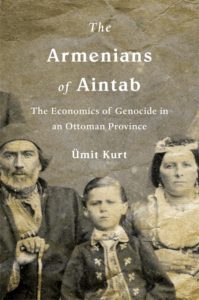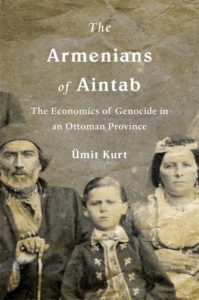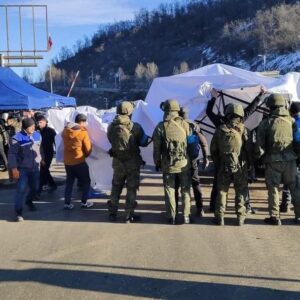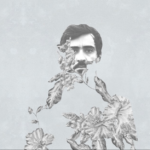 The Armenians of Aintab: The Economics of Genocide in an Ottoman Province
The Armenians of Aintab: The Economics of Genocide in an Ottoman Province
By Ümit Kurt
Harvard University Press, April 2021
400 pp.
$45.00
As an Aintabtsi Armenian, Dr. Ümit Kurt’s book The Armenians of Aintab; The Economics of Genocide in an Ottoman Province pushed me to rediscover Aintab both in its glorious and grey period. My background on Aintab has been deeply attached to the stories of my paternal relatives who came from the cosmopolitan city of Cilicia, bringing with them their rich culture and patriotism. However, I had little idea about the economic background of the city.
The author begins with a brief background of the history of the Armenian community in Aintab. Aintab was developed through trade and artisanship in the 16th century and became a center of commerce, as various trade routes passed through the city. The enrichment in economic life contributed to the growth of the Armenian population in the city. In the 19th century, the Armenians of Aintab were already ahead of the Muslim-Turkish community in terms of economic and commercial activities. The majority of artisanal businesses were controlled by the Armenians. Education also played a huge role. Missionaries founded two educational institutions which eventually shaped and changed the status of Armenians as educated communities. In addition to missionary schools, the community also had its private schools. Armenian schools helped to strengthen a national identity while encouraging cultural modernization. Armenian educational and cultural programs led some to speak of Aintab as “the Athens of Cilicia and Anatolia.” Hence, the rise of the Armenian middle class in Aintab was viewed by the Turks as a threat to the traditional millet (confessional community) system that had long regulated the lives of the non-Muslims in the Ottoman Empire. This factor played a crucial role in shaping the Genocide and the confiscation of Armenian properties.
Dr. Kurt’s book highlights how the confiscation, liquidation and plundering were common throughout the entire region during the Genocide. Using Armenian, Turkish and Western sources, he analyzes and documents with specificity the liquidation of Armenian movable and immovable properties in Aintab. Dr. Kurt demonstrates how the “Abandoned Properties and Liquidation Commissions” carried out “Abandoned Properties Laws” and performed transactions on the wealth of deported Armenians, including the newly unearthed report and records of the “Aintab Liquidation Commission” that reveal how the “economy of plunder,” as he called it, created intersecting political or ideological and material interests among local collaborators.
Kurt introduces a series of studies of the nationalization of state practices at the local level. He mainly discusses the expropriation and liquidation of properties and businesses of Armenians, their forced mass deportations and their extermination.
Within this context, the author explains how the “Committee for Union and Progress” (CUP) engaged in radical economic practices toward the Armenian confiscated properties. First, they transferred many Armenian businesses and properties to state institutions. Second, a lesser but substantial number of firms were transferred to “reliable” Muslim individuals and social institutions. One of the objectives of the Young Turks was to nationalize the Armenian economy. Hence, he has argued that the transfer of the “Armenian capital” was the economic background of the Armenian Genocide. The author shows how the Muslim elite and Aintab’s Turks benefited from the implementation of the genocidal policies.
Interestingly, unlike other surrounding towns, Aintabtsi Armenians were very well integrated into Ottoman society. Many Armenians joined the Young Turks; Armenian political parties later established their own branches in the city. As the 1908 constitutional revolution broke, many Armenians sought equal rights and freedom. However, the enthusiasm of Armenians of Aintab during the 1908 uprising didn’t last long. The horrors of the Adana massacre a year later spread all over Cilicia. By the end of July 1915, Armenians of Aintab were already being deported from their town. In May 1915, the Ottoman Empire imposed a series of laws and regulations such as the “Abandoned Properties Laws” aiming to confiscate Armenian properties. At a later stage, Muslim immigrants and tribes were settled in vacated Armenian villages including Aintab.
After the defeat of the Ottoman Empire and the French capture of Aintab in November 1920, Armenians hoped to return to their hometown and live in dignity. Although many Armenian deportees returned, their properties were either destroyed, sold or confiscated by the government. Local Muslims resisted the return of the Armenians. They viewed the Armenian presence as the real force behind the French military presence in the region. Realizing that they would soon lose their fortunes, the Muslim elite agreed upon armed resistance and decided to provide logistic and financial support to the Kemalist forces. The return of the Armenians to Aintab led to a conflict with Muslim immigrants who had been settled in their houses. As the author describes, the “return” for some necessarily meant “eviction” for others. The issue was worsened by the fact that many of the houses’ current occupants had no place to go.
The French failed to solve the problem. Under intense pressure from the Kemalist forces and without informing the Armenians, in November 1921, the French announced their intention to evacuate Aintab, creating panic among the Armenians. In December 1921, eight-thousand Armenians left their belongings and evacuated their hometown; their possessions and property were later confiscated by the Kemalists.
However, the Armenians of Aintab never gave up and continued pressuring the allies to resolve the issue of their confiscated properties. As Armenians pressed, Turks resisted. Even during the Lausanne talks, Turkey refused the mass return of Armenian refugees for “national security” reasons. Ismet Pasha stated that Armenians’ “return to Turkey is dependent on the permission of the Turkish government, and this permission only can be given to those who keep to themselves and in the past did not have bad behavior.” Turkey pronounced all Armenians, without exception, to be “harmful people” and banned them from entering the country.
From the book, we can understand that the confiscation of Armenian properties was both politically and economically motivated. The expropriation of Armenian wealth in the Ottoman Empire, according to the author, clearly evinces how an essentially ideological process came to incorporate highly diverse motivations and interests, especially material ones.
Therefore, according to the author, the economic rivalries were overladen with ethno-religious hierarchies in the late nineteenth century in Aintab. The belief among members of the dominant nation that the normative social order was being gravely upset was shaped by the “nationalization” of the Armenian nation under the modernizing influence of a burgeoning Armenian middle class. Muslims and Turks viewed this development with concern. Important members of Aintab’s urban Muslim elite, clergy and local government were implicated in scapegoating Armenians and in cheerleading the mass killings and deportations.
Kurt concludes by arguing that the properties that Armenians were forced to abandon were expected to serve, however, yet another patriotic purpose: to strengthen an already national bourgeoisie in Aintab. Those in Aintab late in possession of Armenian property, no longer vulnerable to challenge, used their political power during the Republican era to consolidate their hold on these assets. When Armenians left Aintab for good, their properties were distributed to Muslim notables, and they thereby formed the foundation of the city’s bourgeoisie. Thus, the rich and wealthy Turkish-Muslim class whose foundations were laid in Aintab during the period between 1915-1918 consolidated its status in the weeks between December 1921 through January 1922, when the exodus of Aintab Armenians was made irreversible. Hence, the elimination of the Armenians in the Ottoman Empire paved the way for the rise of a new upper class in modern Turkey.
The article was originally published in the Armenian Weekly, 12/12/2023.
Yeghia Tashjian is a Lebanese-Armenian regional political analyst and researcher. He graduated from the American University of Beirut in Public Policy and International Affairs. He also participated in and graduated from Swedish Defense University’s “Strategic Leadership in Global Societal Security Programm” (2022). He pursued his BA at Haigazian University in political science in 2013. His MA thesis topic was on China’s geopolitical and energy security interests in Iran and the Persian Gulf, currently, he is researching on the Turkish-Russian “co-opetition” in the MENA+ Caucasus region. He is a contributor to various local and regional newspapers, a columnist in the Armenian Weekly, and presented various topics from minority rights to regional security issues. He is an Associate Fellow at the Issam Fares Institute for Public Policy and International Affairs at the American University of Beirut and a part-time instructor in International Affairs at the American University of Science and Technology-Beirut.







